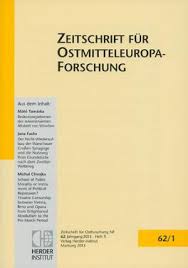(Historische) Geografie des Schwarzmarktes in der Volksrepublik Polen
(Historical) Geography of the black market in communist Poland
Author(s): Jerzy KochanowskiSubject(s): Historical Geography, Diplomatic history, Political history, Recent History (1900 till today), International relations/trade, History of Communism
Published by: Verlag Herder-Institut
Keywords: (Historical) Geography; black market; communist Poland;
Summary/Abstract: A similar process occurred in all communist countries: a top-down revolution – in many cases an imported one – that extinguished the free market and replaced it with a centrally planned economy, a step that inevitably led to shortages. The socialist black markets which arose as a result, display many common, and some individual features. These depended, for example, on the level of shortage, historical experience (traditional attitudes towards respecting or not respecting the law), social structure, the prevailing political and international situation, as well as the size of the country. The present article analyses the way in which geographical and historical circumstances affected the various forms taken by the black market in post-war Poland (1944-1989), for there is no doubt that, for instance, the borders fixed during the partitions of the country, or the Second World War, with its border changes and concomitant mass emigration, are still affecting political, economic, and cultural life in Poland down to the present day. The distribution of poverty and prosperity, the extent of modernisation (in its widest sense), and patterns of political behaviour, still correspond to a great extent with these historical borders. During the lifetime of communist Poland, the hilly and mountainous South and the Northern regions on the Baltic both represented what one might describe as booming regions for black market trading. The pivotal reason for this were geographical and historical factors, which, in this case, exercised an enormous influence on local social, economic, and even political conditions. This can be most clearly seen in Zakopane (and Podhale inthe Carpathian foothills) in the south, and in the coastal region (particularly around Danzig) in the north. Apart from the north-south divide, with Zakopane and the Baltic coast, the article also compares the eastern and western border areas. Both on the river Oder and on the river Bug the borders showed that two neighbouring communities, regardless of the stereotypes, prejudices or historical background, always function like two interconnected tubes. A very slight difference of level in one is enough to set off a corresponding movement of people, ideas, or, in the case of the black market, goods, to the other. The article also shows the difference between the way black markets in the middle of cities and those on the outskirts functioned. The big city centers provided an excellent basis for developing black market trading strategies. The way business was done in the city markets was a world away from the traditional, often downright pre-industrial, forms of barter which largely characterised the provincial markets of the countryside. In cities, black market traders were not limited to groups known to each other, often for generations, but used “modern” business methods. On the outskirts of the cities, on the other hand, where the state sanctioned a higher level of private commerce, the attitude of state officials to spontaneous commercial activity was more liberal. Outlying areas of cities, especially in comparison to the industrial centers, often suffered supply shortages. As a result, the local authorities were often forced to deliberately turn a blind eye to the unofficial trading activities of their citizens.
Journal: Zeitschrift für Ostmitteleuropa-Forschung
- Issue Year: 60/2011
- Issue No: 3
- Page Range: 378-417
- Page Count: 40
- Language: German

